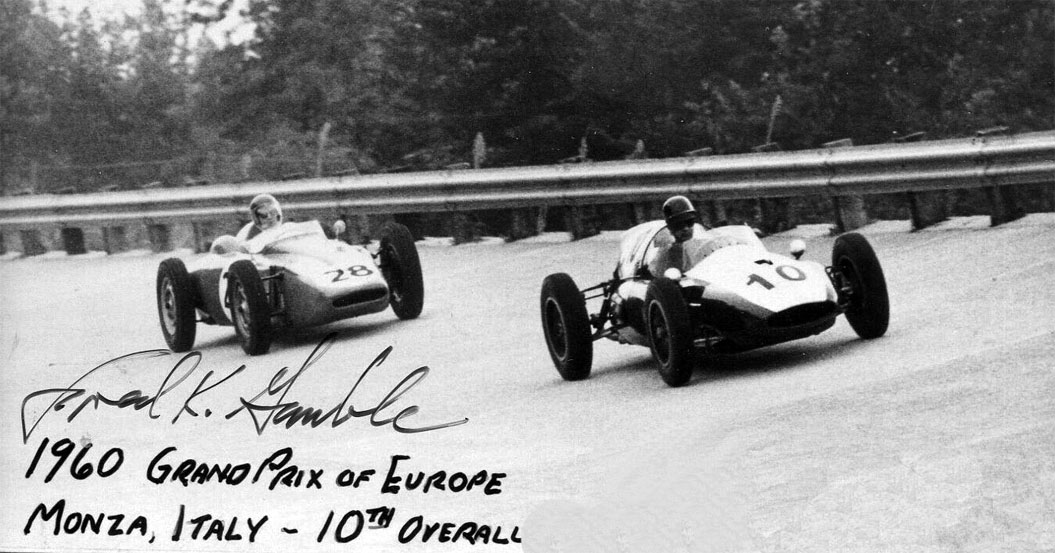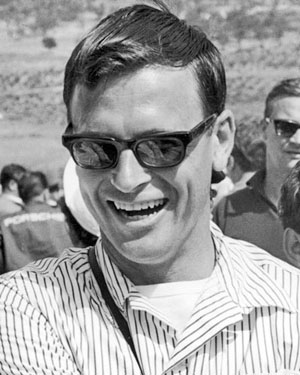Fred K. Gamble (born 17 March 1932 in Pittsburgh, Pennsylvania) is a former racecar driver from the United States.
He participated in one Formula One Grand Prix, the 1960 Italian Grand Prix, on September 4, 1960. He finished 10th overall driving the Formula Two Behra-Porsche, scoring no Championship points. Info from Wiki
Bio by Stephen Latham
Although born in Pittsburgh in 1932, Fred Gamble’s family moved to Fort Lauderdale, Florida at the end of World War 2. A wealthy area, there were many exotic foreign cars and sports cars there and he spent a lot of time hanging around dealers and garages who sold and serviced them. One day, a salesman took 14 year old Fred out for a ride in one of the first MG TCs to arrive in America and he was hooked. He began spending time at a local racetrack and eventually got a job there selling refreshments and programs, plus got to know members of the racing fraternity during his time there. Once he left high school he joined the US Air Force as a radio operator and following this went on to major in mechanical engineering at the California State Polytechnic College at San Luis Obispo. This was followed by a year in the University of Florida, where he continued his ME studies, then switched to a major in advertising.
During this time, he had maintained contact with the SCCA, and when he returned to Florida he became president of the campus sports car club. They organised numerous events and promoted a number of motorcycle and sports car races plus Fred began writing for sports car magazines, including Road and Track. In his last year at university he obtained a used Crossly Hotshot (an American car produced between 1939 to 1952) and discarded the body, fabricated a new aluminium body and added a 750cc motor. He called it a Gambini MK1 and later, on his international license, would call himself Fredrico Gambini. After obtaining his first SCCA National Licence, while at his first race, he got into conversation with a minister who was admiring his car, who then asked if he would be interested in driving for someone else. The minister’s brother happened to be Wendell Jarrard, who was based in Pensacola, Florida, and was the largest importer of foreign cars in the South East USA. Fred was hired to work in his firm’s advertising department and part of the deal was that he would also race. Jarred was running a team of racing Triumphs and Fred began getting regular competition experience. At one race, an SCCA event at Sarasota, he was scheduled to drive a Triumph Standard 10 but the officials refused to allow the car to run, stating there was no class for it to race in as the event was a ‘proper’ sports car meeting. Fred stood his ground and pointed out that Jarrard was an important supporter of the sport in that entire region and that if he wasn’t allowed to enter they might withdraw their team of racing TR3s. The officials quickly backed down and allowed him to drive his Standard in Class G Modified, a six hour endurance race. The race was run in heavy tropical rain but he enjoyed an advantage in the neat, closed, car and drove flat our for the entire race. Many of his competitors were in Lotus 11s, which systematically began dropping out of the race, and Fred found himself the winner in his class.
In 1959, Jarrard decided to withdraw from racing and Fred left and returned to Fort Lauderdale. He started racing an MGA and during this time came into contact with Lucky Casner (ex airline pilot, car dealer and racing driver) who was a well known personality within sports car racing. He had been enjoying considerable success racing a Ferrari Testa Rossa in the South East and had decided to go racing in Europe. Fred also had his eyes set on Europe and he contacted him, offering his advertising and journalistic experience to publicise the venture, though paying his own expenses. Instead, Loyd hired him and this led to the formation of Scuderia Camoradi (an acronym of Casner Motor Racing Division) as an American team competing in Europe. The pair garnered some important support, notably from the Goodyear Tyre & Rubber Company, who began working closely with them on developing road racing tyres. While he was with Camoradi he would often be found in the Palace Hotel in Modena (due to the team’s close involvement with Maserati) and was known to the Modenese as ‘Gambarini’. A happy easy going character, Fred proved invaluable as he knew his way about Europe and knew the European racing scene.
In 1960 he drove a Corvette solo for the full 12 hours at Sebring (with one press article calling him ‘iron man Gamble’) and following this the team headed to Europe with its Corvettes and Maseratis. At the Nurburgring, Fred qualified the Corvette third but didn’t get to drive in the race as co-driver Lee Lilley started though retired due to a seized wheel bearing. At Le Mans, the pair were not classified, with the results listing ’No Distance’. After basing Camoradi’s headquarters in Modena, Casner approached Maserati, who had their new Birdcage T61, and also formed an alliance with Porsche’s Huschke Von Hanstein, purchasing two cars from the late Jean Behra’s estate-a lightweight Carrera and the special Behra-Porsche F2. He was approved to drive the Behra-Porsche in 1960’s German GP, where the car was used by the factory in practice, though Von Hanstein changed his mind at the last minute and denied him the car as it had a ‘works’ engine installed. At Monza, Lotus, BRM and Cooper boycotted the race and as the organisers needed to fill the grid, Fred told them the Behra Porsche might be available, plus him as the driver. Fred found himself accepted as an entry (with $1000 starting money) but he had no authority to use the car. After it had contested a number of European F2 races (by Hans Hermann and Masten Gregory) it had been sold to an American enthusiast, who put it in storage in Modena. Fred managed to track down and contact the owner, who readily agreed to him using it for the race. Fred discussed the race with the car’s builder, Giorgio Neri, who reasoned the car’s fuel capacity would allow it to run non stop in the race. The Porsche factory team were at Monza and they gave Fred assistance plus Phil Hill, Wolfgang von Trips and Richie Ginther all generously helped coach him and advised him on the racing lines to take. In the race, he was running eighth at three quarter distance but ran out of fuel though was so groggy from the pounding of the uneven surface that he could hardly stand but he ran back to the pits for fuel. After being given a five gallon can, he struggled the half mile back to the car and after refuelling went on to finish tenth.
He and team mechanic Bob Wallace took a Corvette and a Maserati to the Swedish sports car GP, with Jo Bonnier taking second place in the Birdcage and L.Casner won the GT category. Bonnier also took both cars to a highway and set a Swedish Land Speed record with the Maserati and a GT record in the Corvette. Fred was scheduled to drive in Goodwood’s Tourist Trophy race but while the car was being driven in Sweden, with B.Wallace at the wheel, it flipped and the Corvette was destroyed. In October that year he left Camoradi and while working as a journalist at Nassau, he was approached by racing patron Frank Harrison, who had bought the ex-Camoradi Le Mans Streamliner and had just won the American pro-sports car Championship with Carroll Shelby and Jim Jeffords. He proposed that Fred drive the Streamliner Birdcage and 450S Maseratis in National SCCA events and following that, the plan would be for 1962 to get the latest Cooper or Lotus and contest a National Championship and if that was achieved, they would attempt a Formula One challenge for 1963.
Although a reserve driver at Sebring in 1961 he started at Marlboro and finished second to Bob Holbert in a Porsche RS61. He went on to take further podiums at Cumberland and Bridgehampton, plus fifth at Virginia and Meadowvale and seventh at Road America and finished third in the championship to Roger Penske and Walt Hansgen. At the end of the year, he raced he also raced an Ol’ Yaller Mk1V Buick in December’s Nassau Trophy in the Bahamas.
Following this he moved away from racing and started work in New York as Assistant Advertising Manager for Standard-Triumph North America. He was involved in the introduction of their TR4 plus he and his boss Mike Cook pioneered the Triumph competition programme. In 1962, Carroll Shelby presented his first Cobra to Ford and after receiving their support took it to New York to show to the International Motor Press Association, of which Fred was a member. After sitting together at the luncheon, he told how he had to set up a company to produce his Cobras and hired Fred as his first Sales Manager. The Cobra’s first race was at the Riverside Sports Car GP and while there the pair got together with Goodyear’s General Manager of Racing, Tony Webner. He wanted to expand Goodyear in racing and go to Europe and the three worked to convince the company to approve an International Racing Tyre Division. In 1963 Fred became Manager of Racing Field Operations and took part in the firm’s early Indianapolis efforts plus was involved in NASCAR and sports car racing activities. Goodyear talked him into becoming their European manager and setting up a Racing Division at their UK base in Wolverhampton to start a serious attack on Formula One. Walt de Vinney, a Chief Engineer, went with him and by October 1964 the Goodyear Grand Prix Tyre Division was up and running. From this modest start, within just 5 years Fred and his team had achieved seven World Championships and 3 Le Mans victories (Ferrari 1965 and Ford 1966/67), Goodyear’s first F1 win (Richie Ginther Honda. Mexico 1965) and Dan Gurney’s historic All-American 1967 Belgian GP win.
However, the workload involved infinite work, planning and travel and not much time for family life or anything else so he eventually handed over control to Leo Mehl and moved into General Management. He became Sales Director at Goodyear’s New Zealand headquarters in Wellington and in later years moved to Colorado where he ran a ski resort.





